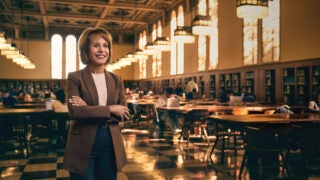Mapping the Future: Donors with Vision
Trustees and their families understand the impact of donating to USC’s health research.
In March, when USC announced that it had received a landmark $50 million gift from longtime benefactors Mark and Mary Stevens, a suite of articles praised their philanthropy. The Los Angeles Times picked up my quote commending the couple’s already spectacular philanthropic legacy at the university, while the Los Angeles Business Journal pointed out that they would endow and name “one of the leading brain research facilities in the nation.” All of this heralded an institute whose scope and significance exceeded the hype: the USC Mark and Mary Stevens Neuroimaging and Informatics Institute.
But, in reading the coverage, what I found most gratifying was the fact that it never lost sight of the purpose of the Stevenses’ philanthropy.The Almanac, a publication based near their home in Atherton, California, noted that their gift promises to improve the lives of millions of people worldwide, and that it will speed the translation of basic research into new therapies, and cures for brain injury and disease. These benefits are very real and will touch countless human beings, with direct implications for those living with Alzheimer’s, schizophrenia, autism, epilepsy, traumatic brain injuries and learning challenges.
For the Stevenses, the fight is as personal as it is noble. “My father has Alzheimer’s and one of our sons is dyslexic,” Mark told the Chronicle of Philanthropy. In that same interview, he spoke of the transformative power of the gift and how it would allow USC researchers to use big data to advance their work. “Our understanding of the brain right now is very coarse,” Mark explained. “It’s like looking at the Earth from far away and seeing only the outlines, when what you really want to be able to see are the details.”
Indeed, their gift is a tremendous vote of confidence in Professors Arthur Toga and Paul Thompson, two of the world’s most prominent and prolific researchers in the field of neuroimaging. At USC, Professors Toga and Thompson lead a dynamic team of 130 faculty researchers and multidisciplinary staff, and together they have achieved an impressive list of firsts. The team was the first to map the spread of Alzheimer’s disease in the living human brain, and the first to create comprehensive, population-based, digital 3-D atlases of the brain to examine the effects of neurological diseases. This group was also the first to uncover advances that have profound implications for attention deficit hyperactivity disorder and HIV, and the first to assemble and integrate large quantities of data toward a comprehensive picture of the brain.
The Stevenses’ gift—when considered along- side their previous gifts for the USC Stevens Center for Innovation, the Stevens Academic Center for our student-athletes, and the USC Caruso Catholic Center—places them squarely among the most illustrious benefactors in our university’s history, as well as among our nation’s most distinguished philanthropists in the area of higher education. Their gift also puts an exclamation point on an extraordinary semester for our Campaign for USC—and the support shown by our other venerable trustees. As this magazine goes to press, USC received an exceptional $25 million gift from Rick Caruso and his wife, Tina, that will name the USC Tina and Rick Caruso Department of Otolaryngology – Head and Neck Surgery. The Carusos’ generosity will dramatically accelerate the work of those committed to improving human health.
Our university is so fortunate to have the support ofthe Stevenses and Carusos. Their dedication to USC—and their vision for how philanthropy can translate to compassion, champion research and better society—is as far-reaching as it is stellar.



